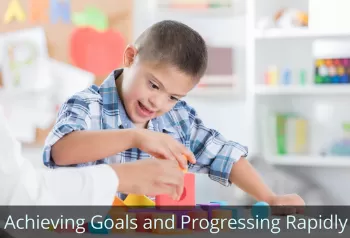Primitive Reflex Integration Case Studies
4-Year-Old Boy with Difficulties Performing Basic Daily Tasks Such as Self-Feeding Is Now Achieving Goals after Three Weeks of Rhythmic Movements
Boy with Cerebral Palsy makes communication and gross motor improvements using rhythmic movements.
This OT helped her client make big gains using rhythmic movements. He is now able communicate using an electronic communication device, stack blocks, and step up onto curbs without assistance. Find out how tools from the Brain and Sensory Foundation program helped!
Submitted by Elissa Cashman, Occupational Therapist

| Before | After |
|---|---|
| Non-verbal | Has begun working with an electronic communication device in order to express himself |
| Had difficulty moving safely throughout various environments | Consistently able to step up onto curbs independently, without looking for an adult to lean on |
| Would not sit to eat meals | Is sitting for up to 5 minutes at mealtimes; participating in more seat work at school and focusing better on tasks |
| Struggled to consistently stack 2 blocks | Able to stack 5 blocks |
Chris B. is a 4-year, 10-month-old boy who is diagnosed with a Chromosome 3q 13 Deletion Syndrome and Spastic Diplegic Cerebral Palsy. He is non-verbal, had difficulty moving safely throughout various environments, and demonstrated significant drooling. He would not sit to eat his meals, and could not get food into his mouth when using a spoon without spilling most of it. Chris was able to walk, stand up from the floor, pick up objects, and feed himself finger foods. He was also able to follow simple one-step familiar directions, especially for preferred activities. Chris has been seen for occupational therapy for a year with me, and 6 months with another OT prior to that.
Chris had made incremental progress, but continued to struggle with basic tasks, such as stacking two blocks, putting a peg in a pegboard, and completing simple large knobbed insert puzzles. His mom had reported that he had previously been observed to perform these tasks, but it was inconsistent. Chris was continuing to work on these aforementioned skills, as well as feeding himself with a spoon, putting a bead on a pipe cleaner, climbing on the platform swing and sitting up, stepping over two-inch high objects, and stepping up onto curbs safely.
I began incorporating Rhythmic Movements [from the Brain and Sensory Foundations course] into his sessions, and began with RM#1. He seeks out vestibular movement, so I felt this was a good place to start. Chris demonstrated all strongly retained Primitive Reflexes, which were significantly impacting his function. He could only tolerate the RM#1 for 10 seconds before rolling away, as it was triggering his Spinal Galant. I then moved on to just the Windshield Wiper movement during the session, for 1 minute. He responded much better to that. I taught Mom all 3 movements, and had her try all of them for brief periods at home, and then attempt to extend the time. Mom had more success with RM#1 before bed time, while he was lying in bed. She reported that he enjoyed that time with her, especially because she was singing his favorite songs. After a few nights, she was able to work up to 8-10 minutes per night, without difficulty.
I noticed, as Chris was participating more in Rhythmic Movement (RM), his oral seeking behaviors increased, and his hands were frequently in his mouth.
"After 3 weeks of performing the movements at home, and 1X/week therapy sessions working on developmental movements and play, Chris began to achieve some of his goals. After RMs in one session, he sat at a table and stacked 5 large blocks in imitation, and then signed 'more'."
He had previously not been able to stack 2 blocks in therapy, and only signed “more” when a swing stopped. Mom reported that Chris began to climb on playground equipment and climb the stairs for the slide. He was stepping from one playground lilypad to another, and was more interested in watching other children. Chris sat for 5 minutes and worked to feed himself with a spoon one dinner time. Just the sitting during meal time was a big change. Chris’ teacher reported that he is participating in more seat work and focusing better on tasks. Chris’ mom also reported that he was now consistently able to step up onto curbs independently, without looking for her to lean on.
Therapy continued to focus on Rhythmic Movements and developmental movements and play. Mom also continues to perform RMs on most days. Chris was able to step up onto a small trampoline for the first time independently, after 2 months of Rhythmic Movement. He is also now able to step over 2-3 inch high hurdles and clear his back leg. He continues to make progress each session, and is being introduced to an electronic communication device in order to improve his ability to let others know what is in his mind and express himself.
[Edited for length and clarity; emphasis added]
*Disclaimer: The activities in the Brain and Sensory Foundations curriculum make use of the natural processes of neuroplasticity and development that are innately wired in the design of human beings to promote maturity and function. These activities appear to calm, organize, and mature the neuro-sensory-motor systems just as we see in the healthy development of human infants. Individual results may vary, and we do not claim to offer a diagnosis or cure for any specific condition or disorder. The Brain and Sensory Foundations activities appear to improve overall functioning resulting in measurable improvements for a range of conditions as demonstrated in over 1800 case studies from participants.

